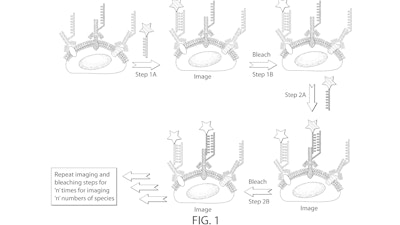Innovations in materials with repellent surfaces, microfluidic device design, high-throughput imaging using DNA nanotechnology, and more
To realize its overarching goal to invent and commercialize disruptive solutions for healthcare, energy, architecture, robotics, and manufacturing, the Wyss Institute is creating a patent portfolio in relevant areas that are or can become an essential basis for specific business development and commercialization efforts. To learn more about these innovations, contact our Business Development Team.
This Wyss Institute’s U.S. patents issued between January and March 2019 are as follows:
Containers, bottles, drums, vats, and tanks having a slippery surface
U.S. Patent 10,233,334 (March 19, 2019)
Joanna Aizenberg, Michael Aizenberg, Sung Hoon Kang, Philseok Kim, and Tak Sing Wong
Abstract: The present disclosure describes a strategy to create self-healing, slippery liquid-infused porous surfaces. Roughened (e.g., porous) surfaces can be utilized to lock in place a lubricating fluid, referred to herein as Liquid B to repel a wide range of materials, referred to herein as Object A (Solid A or Liquid A). Slippery liquid-infused porous surfaces outperforms other conventional surfaces in its capability to repel various simple and complex liquids (water, hydrocarbons, crude oil and blood), maintain low-contact-angle hysteresis (<2.5°), quickly restore liquid-repellency after physical damage (within 0.1-1 s), resist ice, microorganisms and insects adhesion, and function at high pressures (up to at least 690 atm). Some exemplary application where slippery liquid-infused porous surfaces will be useful include energy-efficient fluid handling and transportation, optical sensing, medicine, and as self-cleaning, and anti-fouling materials operating in extreme environments.

Compositions and methods for analyte detection
U.S. Patent 10,227,639 (March 12, 2019)
Daniel Levner, Je-Hyuk Lee, George M. Church, and Michael Super
Abstract: The inventions provided herein relate to detection reagents, compositions, methods, and kits comprising the detection reagents for use in detection, identification, and/or quantification of analytes in a sample. Such detection reagents and methods described herein allow multiplexing of many more labeled species in the same procedure than conventional methods, in which multiplexing is limited by the number of available and practically usable colors.
Radial microfluidic devices and methods of use
U.S. Patent 10,202,569 (February 12, 2019)
Richard Novak, David Conegliano, Liliana Teixeira, and Donald E. Ingber
Abstract: A microfluidic device for simulating a function or response of a tissue is disclosed. The device includes an inlet for receiving a fluid in the device, and an outlet for removing the fluid from the device. The device further includes a fluid channel in fluid communication with the inlet and the outlet for flowing the fluid through the device. The fluid channel defines a chamber well that receives cells associated with the tissue. The device also includes an interface structure between the fluid channel and the chamber well for permitting migration of at least one of cells, particulates, chemicals, molecules, liquids, or gases between the fluid within the fluid channel and the chamber well.
Assembly of nucleic acid sequences in emulsions
U.S. Patent 10,202,628 (February 12, 2019)
George M. Church, Richard C. Terry, Sriram Kosuri, and Di Zhang
Abstract: Methods and compositions for synthesizing nucleic acid sequences in an emulsion are provided.

High-throughput and highly multiplexed imaging with programmable nucleic acid probes
U.S. Patent 10,190,151 (January 29, 2019)
Peng Yin, Sarit Agasti, Xi Chen, and Ralf Jungmann
Abstract: The present invention provides, inter alia, methods and compositions for imaging, at high spatial resolution, targets of interest.
Actuators with conforming sleeves
U.S. Patent 10,189,165 (January 29, 2019
Kevin Galloway
Abstract: An actuator includes at least one actuator body and a sleeve covering a portion of the actuator body. The actuator body comprises a first material, and the sleeve comprises a second material that is more rigid than the first material. The sleeve constrains bending of the actuator body where the sleeve covers the actuator body.

Multi-segment reinforced actuators and applications
U.S. Patent 10,184,500 (January 22, 2019)
Kevin Galloway, Conor Walsh, Donal Holland, Panagiotis Polygerinos, Tyler Clites, Paxton Maeder-York, Ryan Neff, Emily Marie Boggs, and Zivthan Dubrovsky
Abstract: A multi-segment reinforced actuator includes (a) a soft actuator body that defines a chamber and (b) a plurality of distinct reinforcement structures on or in respective segments of the soft actuator body. First and second reinforcement structures are respectively configured to produce a first and second actuation motions, respectively, in first and second segments of the soft actuator or body when fluid flows into or out of the chamber. The actuation motions are selected bending, extending, expansion, contraction, twisting, and combinations thereof; and the first actuation motion differs from the second actuation motion. The actuator can be used, e.g., to facilitate bending of the thumb with corresponding bending, extending, expansion, contraction, and twisting actuation motions.
Methods for high-throughput labelling and detection of biological features in situ using microscopy
U.S. Patent 10,179,932 (January 15, 2019)
George M. Church, Je-Hyuk Lee, and Evan R. Daugharthy
Abstract: Methods of labelling one or more subcellular components (e.g., an organelle and/or subcellular region) in vivo are provided. Methods of labelling a protein in vivo are provided. Methods of determining a nucleic acid sequence in situ are also provided.
